Menus
- The right machine for the bad boys !
- Discovery
- In the saddle
- In the city
- Motorway and expressways
- Departmental
- Part-cycle
- Braking
- Comfort / Duo
- Consumption
- Conclusion
The right machine for the bad boys !
Initiated in 1972, the Z saga is a story of heavy mechanics and strong character. After the 900 cc Z1, the first name Z 1000 appeared in 1977 and already designates a large roadster among the most efficient of the moment.. Abandoned in 1983, the Z 1000 series made a noticeable comeback in 2003, taking on the heart of a sportswoman (block of the ZX-9R) and equipped with injection. Benefiting from an already radical design and quality equipment, the Z wins the votes of many bikers succumbing to its revolted style.
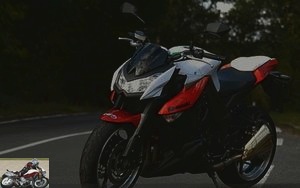
Building on this success, the model was redesigned in 2007. But competed by its younger 750 and hit by its less impactful plastic, the new Z receives a more mixed reception. And the remarkable arrival of an expressive and efficient Honda CB 1000 R shakes up the Tokyo firm.
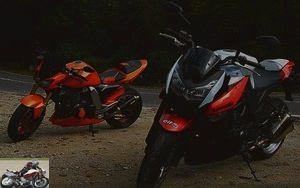
In order to regain the lead of the race for nasty roadsters, the 2010 vintage unveils a bodybuilt, racy machine which, like 7 years before, inevitably attracts attention..
The "Zèd" is back … without compromise.
Discovery
Gone are the days of the naked Big One, XJR 1300 and other Speed T 301s … No more basic skinning that meant virility. Aesthetics are in power and dress the new muscular street bikes with sharp angles and stops.
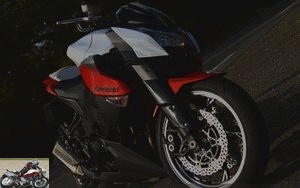
The new Z 1000 imposes its athletic physique. Its style, much more assertive than that of its Honda competitor, is not, however, as outrageous as that of a B-King. Kawasaki has managed to combine aggressiveness and elegance. First of all by offering two-tone colors that break up the lines and underline the design of the machine. Then, by effectively integrating the optical unit into the body of the model.
The whole is dynamic and harmonious.
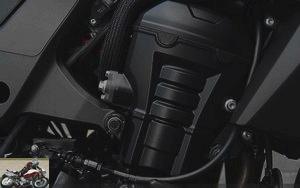
Of course, the "Manga" style, which is an integral part of the recent history of the Z, remains present, but is mastered in this 2010 vintage. It is above all an impression of sport that stands out the most..
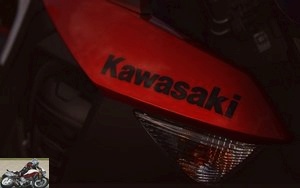
This is also a reality: from the sports ZX 9 R and ZX 10 R, the engine block, with its discreet and neat design housings, is impressive and massive, underlined by long scoops including the indicators. These frame the optical unit which takes up the angular lines of a design that has become a signature. The lighthouse projects a sharp beam…
We also note the inverted fork, fully adjustable, covered with a fairing that protects the legs and optimizes air flow according to the manufacturer. In the same spirit, a large shoe covers the lower engine.
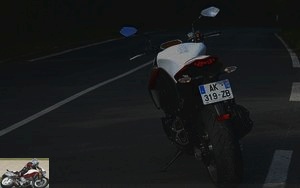
The frame design, with its beautiful matte black coating, is also inspired by its sporty sister. All aluminum, 30% more rigid and 4 kg lighter, it encloses the engine, which also contributes to rigidity, by 4 anchoring points.
But Kawasaki has also clearly emphasized the quality of the finishes. To put the brakes on the whole thing, they are very aesthetic and powerful four-piston radial calipers that bite into the 300mm double petal discs up front. The rear receives a single piston for a 250mm single petal disc. The rims are polished, the welds discreet, the taillight with a sharp and well-known look is LEDS.
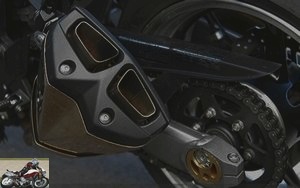
The exhausts, still significant elements of the Z spirit, are more compact and much better integrated than those of the 2007 vintage and have a flat internal surface. Externally, an angle on each pot finely emphasizes the two gas outlets of rectangular sections. Seen from the rear, this design helps to refine the silhouette of the roadster, as does the reduced-section banana swingarm. There is also an eccentric chain tension adjustment.
We can only regret the presence of some coarse connections and the horns a little hastily placed near the exhaust manifolds.
In the saddle
Looking thin and light compared to the front, the rider seat is particularly welcoming, making the seat of the potential passenger all the more cramped. In use, however, its position is very correct: legs and back almost finding a comfortable position. Especially the passenger benefits from real grab handles hollowed out under the rear shell; the strap being there only for homologation.
The plates of its toe clips also incorporate hooks allowing the use of turnbuckles.
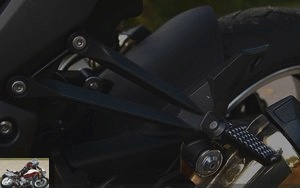
The instrumentation unit is just like the rest: futuristic and angular. Wider than high, with an orange background and of course fully digital: tachometer, tachometer, odometer and 2 partials, fuel gauge and clock. In comparison to some over-electronized models, it looks almost poor. In fact, we would appreciate an engine temperature and gear indicator light..
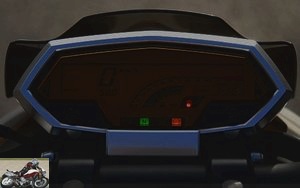
Placed above a particularly low headlight unit, this information is not easy to read and requires you to really look down … Almost as much as on a Ducati Monster. On the other hand, this dashboard is easily adjustable in 3 positions, using a thumbwheel.
The tank, wide and angular, allows you to grip the motorcycle well. The mirrors although small, transmit a good vision, perfectly clear.
The clutch control is wired, the wide handlebars provide good support and its attachment to the fork is quite successful. The commodos are up to the standards of the genre but do not include a warning !
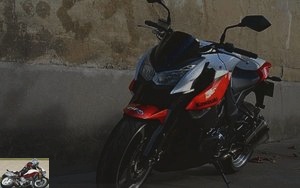
In the city
A quarter-turn of a coded key illuminates the LCD panel and the large 4-cylinder comes to life with a full, muffled roar. The first clicks a bit and the Z takes off with surprising smoothness. Above all, it’s handling that impresses. Lively, precise, weighing only 218 kg fully loaded (221 kg with ABS) city driving is a pleasure. With the body tilted slightly forward and the feet tilted to the rear, the position is optimal.
Another pleasant point, it is possible to restart in 6 ° at 35 km / h and less than 2000 laps! The clutch would almost be of no use! Urban evolutions are a real pleasure, especially as the slightest rotation of the throttle grip is a quick reminder that the original 138 horses (even bridled) are not fictitious…
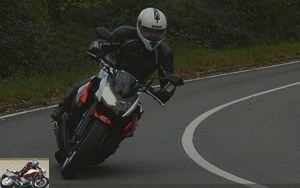
Motorway and expressways
It’s hard not to consider the slightest slip road as an orbiting route … crossing the corner of a single block, you are instantly stuck at the legal 130 km / h, at 5,700 laps. Knowing that barely 1,000 more laps you will progress to 150, that the red zone is set at 12,000 revolutions / minute and that your license counts, at best, 12 points … calculate the amount of shameful pleasure you have left in the hands … and it’s good … shame..!
Obviously, you will have to deal with the total lack of protection, which still reduces the inclinations of long trips at good speed. But this is not to speak frankly the primary orientation of this machine.
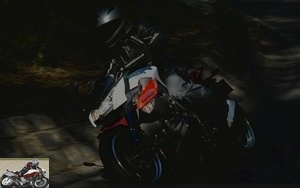
Departmental
You’ll go hunting for turns and "buddies" like others go for mushrooms. The slightest small winding road is an excuse to test your own limits. The new Z tilts from one curve to another naturally and its four-cylinder heart is likely to vibrate as much as yours: yet already full from 3,000 revs, it becomes furious at 5,000 and explodes at just over 7,000 revs, delivering its maximum torque of 11.2 m / kg !
The thrust is constant up to the switch and this engine requires a minimum of concentration … because the cycle part follows without flinching the engine hurricane.
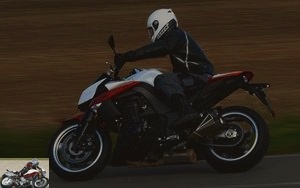
Part-cycle
The 41 mm fork easily supports significant mass transfers and the rear suspension, whose horizontal shock absorber and rods are newly positioned above the swingarm, works wonders, erasing the defects of the asphalt and allowing a resolutely sporty ride. . And you don’t have to be a seasoned pilot to fully benefit from the qualities of this "toy" Zoli.
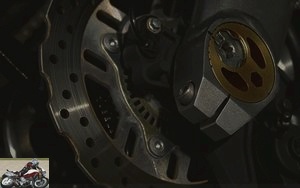
Braking
Particularly dosable and powerful, the front braking is very efficient, providing an excellent feeling. This test model uses an ABS system that is as neutral as it is effective.
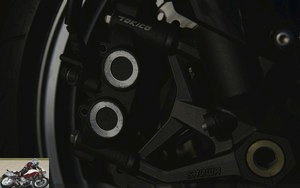
The rear brake is similar to the front and balances the bike both when decelerating in a straight line and at an angle.
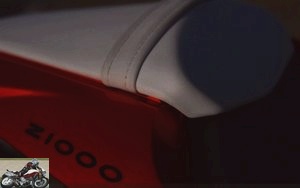
Comfort / Duo
Joker? Not really. But the hard and narrow seat will limit the duo stages at the goodwill of your companion.
Consumption
With a 15-liter tank and an engine that makes you want to burn unleaded … you’ll rest from your exploits every 180 kilometers on average. Perhaps an element of safety … much more surely a consequence of registering this machine in the urban and peri-urban sector as well as in the realities of consumption of this explosive product.
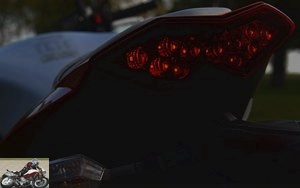
Conclusion
Kawasaki has transcended its big Z Integrating a number of dynamic and technical novelties. The nasty roadster still logically skips certain practical elements. It’s even quite pleasant not to have electronic assistance to manage.
The quality choices of cycle part equipment prove to be fair and extremely efficient. Admittedly, the bill is affected by the purchase: offered at 11,899 € with ABS and at 11,299 € in the basic version, the 2010 vintage follows the inflationary trend but rather justified.
Efficient in both design and dynamics, the Z is a rational machine, carefully designed. As pleasant in the city as on the road, available but docile, flexible but oh so angry if necessary, this Z shows that a manly roadster can also be a great pleasure in everyday life..
Its ubiquitous couple is a delight in urban development as much as its assertive character as soon as space becomes available: a motorbike worthy in almost every way.
Strong points
- motor character and flexibility
- cycle part
- braking
- transmission smoothness
Weak points
- dashboard ergonomics
- autonomy
- duo
Test on the test forum
Competitors: Honda CB 1000 R, Suzuki Bandit 1200,
Triumph Speed Triple, Yamaha
Fazer 1000
2003 vintage test
The technical sheet / comparo
2003/2007/2010
Related articles
-
Japanese legend, successor to the GSX1100S Katana 4 cylinders in line, 999 cm3, 150 hp, 108 Nm, 215 kg full made, 13,699 euros The Katana is a very old…
-
Kawasaki Versys 1000 motorcycle test
La Z goes green Eternal absent from the Kawasaki range, apart from the unlikely KLV 1000 (Suzuki V-Str m renamed), the maxi-trail model finally appears…
-
Evolution Like few models, the Z can boast of having built a first name within its own brand. After eight years of hegemony in the flagship motorcycle…
-
Kawasaki Z1000 SX motorcycle test
The Z sport-touring, Super exciting ! Two-day trial in Spain in Malaga Ten months after the official launch of the nasty Z 1000 roadster, the Akashi firm…
-
Ducati Monster motorcycle test
Salon revolution V-Twin Testastretta of 937 cm3, 111 hp, 93 Nm, 166 kg dry (188 kg full made), 11,290 euros Is a Monster still a Monster if it doesn’t…
-
2012 Kawasaki ER-6n motorcycle test
New test: Kawasaki ER 6N: Sparkling with mischief ! Appeared in 2006 and restyled in 2009, the ER6 N gets a new facelift that makes it even sexier,…
-
Suzuki GSR 750 motorcycle test
The way of the Samurai Following an almost Darwinian principle, motorcycle models are constantly evolving and by period. Thus, the era of the 600cc…
-
Roadster with Sugomi sauce or decarenated sports car A2 licenses have the choice between large bridles, sometimes very badly bridled, and smaller ones,…
-
Kawasaki ER-6 N motorcycle test
A very stylish and punchy little urban The city of Mozart sounded for three days of a superb symphony in major exhaust. Orchestrated by Kawasaki making…
-
Kawasaki Z 750 R motorcycle test
The Z super Roadster version ! There are emblematic models by their distribution, the commercial enthusiasm they arouse. The Z 750 is in this vein. With…